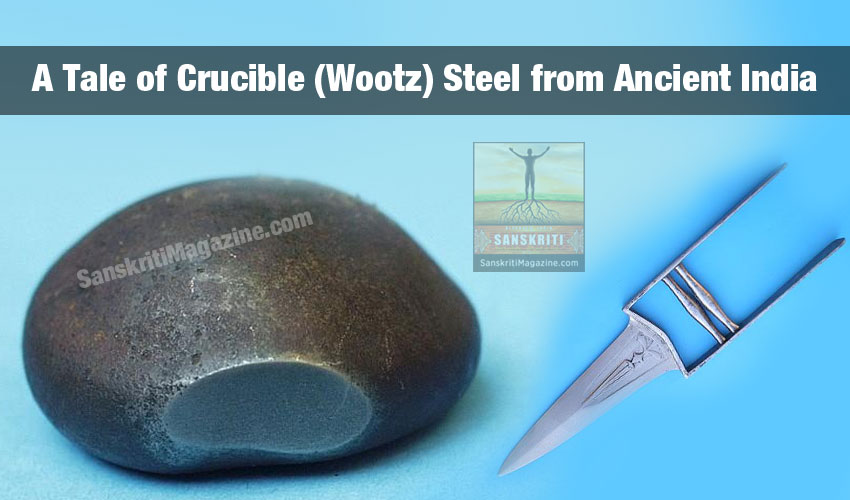The extraordinary romance and thrilling adventure associated with the tale of wootz steel shows how Indian metallurgists were the world leaders in antiquity in the manufacture of this legendary high-grade steel. In many ways this material was brought to global attention by the writings of Cyril Stanley Smith. Modem metallurgy and materials science rest on the foundation built by the study of this steel during the past three centuries.
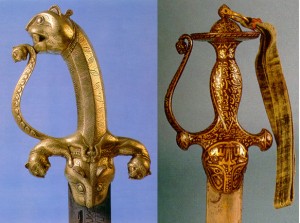
Wootz steel was highly prized across several regions of the world over nearly two millennia and the products made of this Indian steel came to be known as Damascus swords. Figure I shows a splendid example of the sword of Tipu Sultan. It is no exaggeration to state that wootz steel as an advanced material dominated several landscapes: the geographic landscape spanning the continents of Asia, Europe and the Americas; the historic landscape stretching over two millennia as maps of nations were redrawn and kingdoms rose and fell; the literary landscape as celebrated in myths and legends, poetry and drama, movies and plays; the linguistic landscape of Sanskrit, Arabic, Urdu, Japanese, Tamil, Telugu and Kannada. It held sway over the religious landscape through trade and other interactions of Hinduism, Buddhism, Zoroastrianism, Judaism, Islam and Christianity. This is unique as no other advanced material can display this multifaceted splendour.
The development of wootz steel by sheer empirical practice in Southern India, the fashioning of the steel by thermo-mechanical treatments to fierce and beautiful Damascus Swords in India and the Middle East with little knowledge of the underpinning science is a remarkable tale in the annals of metallurgy. When this steel was presented to the Western world, scientists In England, France, Russia and Sweden toiled hard and discovered the composition and microstructure and their relation to mechanical properties. This single-minded pursuit of an Eastern technological product by Western scientists for over a century created the foundations of modern materials science. Cyril Stanley Smith has emphasized this theme in his writings. In addition there is a possible connection with nanomaterials and computer modeling. Thus the investigations on wootz steel continue to inspire researchers to this day.
Iron and Steel Heritage of India
India has been reputed for its iron and steel since ancient times. The Delhi Iron Pillar is a marvellous monument. There are numerous early literary references to steel from India from Mediterranean sources including one from the time of Alexander (3rd c. BC), who was said to have been presented with 100 talents of Indian steel. Arabs took ingots of wootz steel to Damascus following which a thriving industry developed there for making weapons and armour of this steel, the renown of which has given the steel its name. In the 12th century the Arab Edrisi mentioned that the Hindus excelled in the manufacture of iron and that it was impossible to find anything to surpass the edge from Indian steel. The famous novel “The Talisman” by Sir Walter Scott narrates the encounter between King Richard of England, known as Lion Heart and Sultan Saladin during the third crusade. Though this 1825 account is fictional, it is evident that the fame of the swords made out of wootz steel spread to Europe, when the crusaders encountered them at Damascus. One possible origin for the term Damascus swords is traced to this encounter. In 1912, Robert Hadfield who studied crucible steel from Sri Lanka recorded that Indian wootz steel was far superior to that previously produced in Europe.
It is ironic that not too many records are available documenting the process of wootz production. It is mainly the European travelers who left detailed accounts. These include Francis Buchanan in 1807, Benjmain Heyne in 1818, H W Voysey in 1832 and Josiah Marshall Heath in 1840. They observed the manufacture of steel in south India by a crucible process at several locales including Mysore, Malabar and Golconda. By the late 1600’s shipments running into tens of thousands of wootz ingots were traded from the Coromandel coast to Persia. This indicates that the production of wootz steel was almost on an industrial scale in what was still an activity predating the Industrial Revolution in Europe.
The word wootz is a corruption of the word ukku for steel in many south Indian languages. Indian wootz ingots have been used to forge Oriental Damascus swords which were reputed to cut even gauze kerchiefs and were found to be of a very high carbon content of 1.5-2.0% and the best of these were believed to have been made from Indian steel in Persia and Damascus according to Smith. In India till the 19th century swords and daggers of wootz steel were made at centres including Lahore, Amritsar, Agra,Jaipur, Gwalior, Tanjore, Mysore and Golconda, although none of these centres survive today.
It may be mentioned however that the term Damascus steel can refer to two different types of artefacts, one of which is the true Damascus steel which is a high carbon alloy with a texture originating from the etched crystalline structure, and the other is a composite structure made by welding together iron and steel to give a visible pattern on the surface. Although both were referred to as Damascus steels, Smith has clarified that the true Damascus steels were not replicated in Europe until 1821. The pattern welded composite swords are the essence of the Samurai and Viking.
The Role of Wootz Steel in the Development of Modern Metallurgy
For centuries iron and steel were thought as being two elements belonging to the ferrous family, just as copper, silver, gold and other metals belong to the non-ferrous family of metals. The recognition that steel is an alloy of iron and carbon came as a result of the chemical assaying of wootz steel in 1774 by the Swedish chemist Tobern Bergman. He was able to determine that the compositions of cast iron, steel and wrought iron varied due to the composition of ‘plumbago’ i.e. graphite or carbon. As suggested by Smith, the Swedish studies received an impetus following the setting up of a factory to make gun barrels of welded Damascus steels, and it was on observation of the black and white etching of the steel and iron parts that a Swede metallurgist guessed that there was carbon in steel, and interest in replicating true Damascus steels followed. The Chemical Revolution wrought by Lavoisier received an impetus with the identification of carbon as an element. Smith has argued that “if the practical man was rather too slow to benefit from the new knowledge of chemistry that was being developed, he can feel that his practical knowledge, by helping the identification of carbon as an element, has contributed in a far from trivial way to the Chemical Revolution itself’.
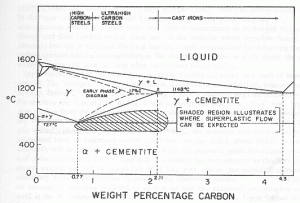
As England had colonized India, there was considerable interest in studying wootz steel. Michael Faraday, the inventor of electricity and one of the greatest of the early experimenters and material scientists was also fascinated by wootz steel and enthusiastically studied it. Along with the cutler Stodart, Faraday attempted to study how to make Damascus steel and they incorrectly concluded that aluminium oxide and silica additions contributed to the properties of the steel and their studies were published in 1820. They also attempted to make steel by alloying nickel and noble metals like platinum and silver and indeed Faraday’s studies did show that that the addition of noble metals hardens steel. Though Faraday failed to replicate the wootz steel, he is hailed as the father of alloy steels.
Following this the interest in Damascus steel moved to France as Faraday’s research made a big impact in France where steel research on weapons thrived in the Napoleonic period. The struggle to characterize the nature of wootz steel is well reflected in the efforts of Breant in the 1820’s from the Paris mint. He conducted an astonishing number of about 300 experiments adding a range of elements ranging from platinum, gold. silver, copper, tin, zinc, lead, bismuth, manganese, arsenic, boron and even uranium, before he finally also came to the conclusion that the properties of Damascus steel were due to ‘carburetted’ steel. Smith has indicated that the analysis of ingots of wootz steel made in the 1800’s showed them to have over 1.3% carbon.
The Russian Anasoff also studied the process of manufacturing wootz steel and succeeded in making blades of Damascus steel by the early 1800’s. In the early 1900’s wootz steel continued to be studied as a special material and its properties were better understood as discussed further in the next section. Belaiew reported that blades of such steel cut a gauze handkerchief in midair.
As studies ofwootz gained, it became imperative to establish the phase diagram of iron-carbon system. The first comprehensive construction is due to Roberts-Austen in 1898. This was the first phase diagram of any alloy ever to be established. Such a diagram made it evident that it is possible to distinguish different products such as wrought iron, plain carbon steels, ultra high carbon steels and cast irons on the basis of their composition (Figure 2) . It was also possible to identify various phases such as austenite, ferrite, cementite. The phase reactions such as peritectic, eutectic and eutectoid came to be established. Combination of phases led to microstructures consisting of pearlite and ledeburite. The use of the optical microscope became widespread due to studies of wootz steel. Figure 3 shows the dendritic microstructure in wootz steel as recorded by Smith.
Deformation and Solidification Microstructures
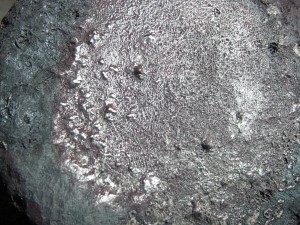
Steel.
Panseri in the 1960’s was one of the first to point out that Damascus steel was a hypereutectoid ferrocarbon alloy with spheroidised carbides and carbon content between 1.2-1.8%. Recent studies have indicated that ultra-high carbon steels exhibit superplastic properties. Wadsworth and Sherby at Stanford University had found that steels with 1-2.1% C i.e. ultrahigh carbon steels could be both superplastic at warm temperatures and strong and ductile at room temperatures. It was only subsequently that it came to the authors’ notice that these steels were in fact similar in carbon content to the Damascus steels.
Contemporary studies by Wadsworth and Sherby indicated that UHCS (i.e. ultra-high carbon steels) with 1.8% C showed a strain-rate sensitivity exponent nearing 0.5 at around 7500 C suggesting that Damascus steel could well have exhibited superplastic properties and a patent was awarded for the manufacture of such UHCS. The explanation of the superplasticity of the steel is that the typical microstructure of ultra-high carbon steel with the coarse network of pro-eutectoid cementite forming along the grain boundaries of prior austenite can lead to a fine uniform distribution of spheroidised cementite particles (0.1 mm diam.) in a fine grained ferrite matrix.
John Verhoeven and the blacksmith Alan Pendray collaborated in the production of modern Damascus blades. Verhoeven has proposed that minute amounts of vanadium were necessary to lead to microsegregation and the formation of banded structures during subsequent processing. Figure 4 shows the banded pattern visible to the naked eye. This texture and its beauty added to the reputation of the Damascus swords.
Materials Science Tetrahedron and Wootz Steel
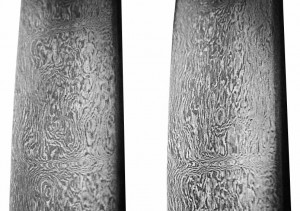
As discussed above, the investigations on wootz steel in 19th century Europe led to the foundations of what we understand today as the central paradigm of materials science. This is based on the idea that the processing of a material leads to a structure, which has a definite combination of properties. This set of properties in turn defines the performance of the possible products that can be made out of these materials. Merton C Flemings and Praveen Chaudhari captured these four defining ideas as the four corners of a tetrahedron. It will be noted that no particular material is mentioned. It applies equally well to metals, ceramics, polymers and composites. It is this powerful generalization that has made materials science a powerful, pervasive and enduring concept. It applies to steel and sand, nylon and nickel, bone The past decade has added one more idea to this Courtesy J 0 Verhoeven quartet of the conceptual framework, namely modelling. As processing, structure and properties become complex, it is possible for us to resort to modelling and simulation. Figure 5 represents the materials science hypertetrahedron for wootz steel. Individual vertices represent processing, structure, properties, performance and modelling. The facets of the Buchanan furnace, the iron-carbon diagram, the microstructure of dendrites in the as-cast state and spheroidised cementite in the forged material, the superplastic elongation, and the Damascene marks are displayed with emphasis on the strong interconnections among them.
Materials science came into being due to the investigations into the properties of wootz steel. As it continued to evolve in the latter half of twentieth century, it took an amazing turn. The question was raised as to whether new materials are to be discovered by experiments or whether it will be possible to design them from first principles. Quantum mechanics offers powerful insights into the structure and behaviour of atoms. Will it not be possible simply to compute and design alloys inside the computer? A major contributor to this field is Greg Olson. He was deeply influenced by Smith’s emphasis on the principle of hierarchy in the structure of materials. He has argued that as the new millennium unfolds, it is ushering in an Age of Design marked by new materials that go beyond the dreams of the medieval alchemists.
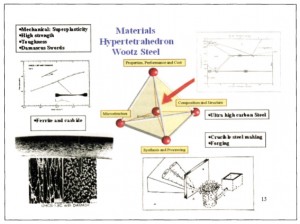
for Wootz steel.
At the coarsest level, solidification is the chemical banding visible in the Damascus swords. It is possible to employ thermodynamics to predict the structures at the 10 mm scale. This may be called “solidification design”. At the next lower level of 1 mm, the structural changes that take place on heat treatment can be modelled. These follow various phase transformations. This may be termed as “transformation design”. When size is further reduced to 0.1 mm scale, design enters the micro-mechanic regime. Grain refining can lead to such small grain sizes. It is possible to use continuum mechanics to follow the flow and fracture of materials. The most exciting level is the next levelthe nanoscopic level. The realm of quantum design begins at the electronic level- the finest level relevant to real materials. The need for modelling and design is best appreciated, when it is realized that the possible combinations of elements for making alloys and compounds is truly enormous. It typically takes a hundred million dollars over two decades to fully develop and qualify a new material using the experimental approach.
Olson went on to found a company christened as QuesTek Innovations. Successful examples from the Northwestern University efforts include a stainless steel bearing for space shuttle applications, high strength, high-toughness steels for aircraft landing gear and armour applications, and a new class of ultrahard steels for advanced gear and bearing applications. Of immense interest to wootz steel is the Dragon-slayer Project. Olson in a dramatic fashion enlisted freshman and upper class design teams to use the most modern and sophisticated computational methods to recreate an ancient steel. As ancient Western literature is replete with dragons, it was felt that a sword named Dragon-slayer would have maximum market appeal. The mystique of the Samurai sword provided the inspiration, as even five centuries ago these swords outperformed all other swords. So the performance specification had to be comparable. In addition, high temperature resistance was an added requirement, as the sword had to deal with fire-breathing dragons! In terms of form for the weapon, a historical precedent of a patterned double-edged sword was to be the example. As a supernatural element is necessary in fighting such mythical beasts, the iron had to be of extra-terrestrial origin. Meteoritic iron, which came from the sky, was the natural primary ingredient. This fusion of ancient legend and modern science proved successful. But it is important to note that in spite of the fanciful tale, the underlying science was of the most advanced kind using powerful computation and sophisticated experimental techniques.
Conclusion
The reputation of wootz steel as an exceptional and novel material is one that has endured from early history right into the present day, with the story of the endeavours to study it in recent history being nearly as intriguing as the story of its past. Recent investigations on the properties of the ultra-high carbon wootz steel such as superplasticity justify it being called an advanced material of the ancient world with not merely a past but also perhaps a future. This account of wootz steel as a legendary material derives its authority from the numerous writings of Cyril Stanley Smith.
~ Professor S. Ranganathan & Dr. Sharada Srinivasan

